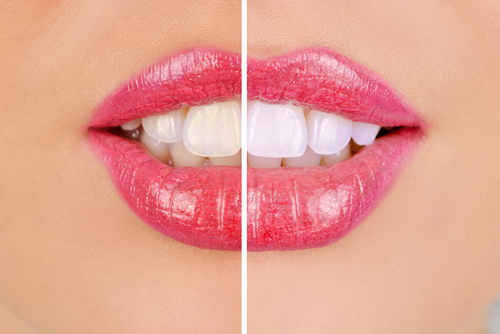
You’ve probably seen the commercials that suggest holding a tissue to your teeth and comparing the color of your enamel to the bright white of the tissue. But have you given yourself the “tissue test” to see if you pass with flying colors, or if your teeth are more dark and dingy than you even realized?
Making the choice to brighten your discolored smile can be easy and cost effective. Read on to determine the best way to whiten your teeth.
Uncovering the Cause of Your Tooth Stains
When it comes to unsightly, stained teeth, there are a few common culprits that are probably causing your teeth to not look their brightest.
What You Eat.
An easy way to determine if a food is going to stain your teeth is to imagine a clean white t-shirt. If the food you’re about to consume would stain the white t-shirt, chances are, it also stains your teeth. The foods that stain your teeth are foods that are dark in color such as dark colored fruits like blueberries or blackberries, pasta sauces, and balsamic vinegar.
What You Drink.
A number of different beverages, including coffee, tea, sodas, sports drinks and wine can cause stains due to the high levels of acidity. Teas of all colors, even white tea, have been shown to stain teeth and erode your natural enamel. Limiting your intake of these beverages that are dark in color and high in sugar will benefit both your oral and overall health.
Poor Dental Hygiene.
Bacteria trapped on and in between your teeth cause plaque to build-up – especially if you aren’t brushing your teeth after indulging in specific foods or drinks that are known to stain your enamel.
Smoking and Tobacco Use.
Tobacco stains tend to affect the outer layer of your teeth and cause them to appear yellow or brown in color.
Age Related Discoloration.
As we age, the enamel of our teeth begins to wear down, leaving our teeth more translucent and revealing the porous yellow tissue under the enamel.
Medication.
Excessive use of fluoride or medications that contain tetracycline can cause dark enamel bands that are hard to lighten at home.
Intrinsic vs. Extrinsic Tooth Stains
Intrinsic
“Intrinsic” refers to whitening the inner part of the tooth, which soaks up hydrogen peroxide gel and causes it to become lighter. When the inner part of the tooth is whitened, the color that’s reflected through the outer enamel of your teeth is lighter, making them appear whiter and brighter.
Extrinsic
Removing stains on the surface of your teeth and your enamel is called extrinsic whitening. The stains left behind by smoking, drinking dark colored beverages, or consuming certain foods can be removed by polishing the surface of your teeth.
When Standard Teeth Whitening is the Best Bet
When considering whitening your smile, the first step should be to have a proper dental exam so you can have help in determining what the cause of your tooth discoloration is. If your teeth require Intrinsic whitening, simple at home whitening kits will not be able to give you the results you desire.
If the surfaces of your teeth are simply stained from what you’ve eaten or drink, a simple at home whitening kit, or whitening toothpaste will be able to give you a brighter, whiter smile in about 7-10 days.
Whitening Your Teeth as Quickly as Possible
In a rush, or have a big event in a few days?
Hinsdale Dentistry offers laser whitening which is faster, more effective and more comfortable than other in-office whitening treatments and at-home whitening kits. We can complete a full whitening procedure, lightening teeth by 4-6 shades, in just 20 minutes!
How to Whiten Dental Work
If you have dental bonding, porcelain veneers, porcelain crowns or another form of dental work, you will not be able to bleach those teeth. Whitening only works on natural enamel, and the dental work will not change its shade. Talk to your dentist about replacing that work, and ways that you can prevent it from becoming stained in the future.
Keeping porcelain veneers white
With proper care, porcelain veneers can keep your smile bright for up to twenty years. Veneers can collect plaque and tartar buildup the same way your natural teeth do, so it’s vital to continue a dental hygiene routine that includes proper brushing and flossing, the right toothpaste, and regular professional cleanings.
Looking to improve your smile with a quick 20 minute whitening treatment right after your cleaning and exam? Contact Hinsdale Dentistry today and schedule your whitening treatment today!